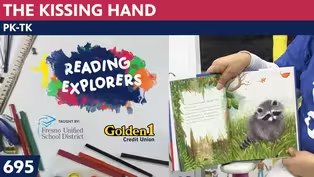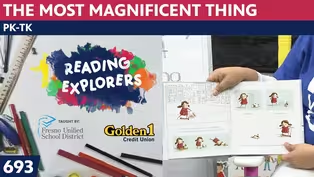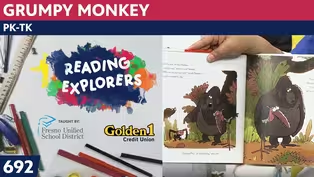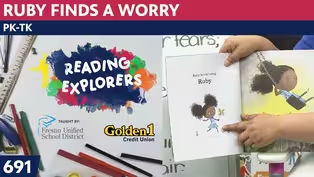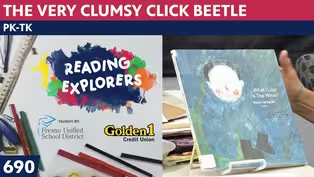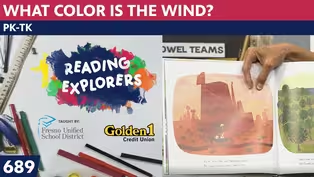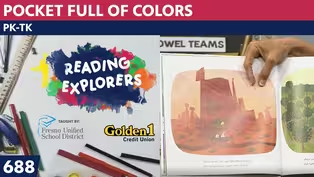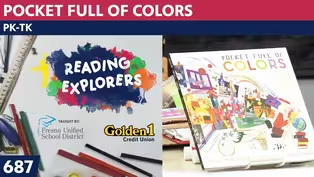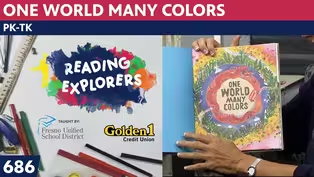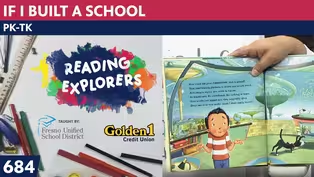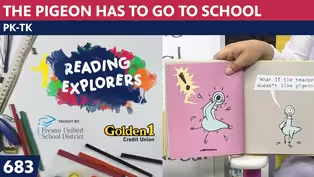
TK-359: 4 is for Confetti Hearts by Jim Dine
Season 3 Episode 326 | 14m 11sVideo has Closed Captions
Join Mrs. Readwright at Camp Discovery!
Transitional Kindergarten teacher, Mrs. Readwright, welcomes students back to Camp Discovery, a fun learning space packed with reading adventures & fun games!
Problems playing video? | Closed Captioning Feedback
Problems playing video? | Closed Captioning Feedback
Reading Explorers is a local public television program presented by Valley PBS

TK-359: 4 is for Confetti Hearts by Jim Dine
Season 3 Episode 326 | 14m 11sVideo has Closed Captions
Transitional Kindergarten teacher, Mrs. Readwright, welcomes students back to Camp Discovery, a fun learning space packed with reading adventures & fun games!
Problems playing video? | Closed Captioning Feedback
How to Watch Reading Explorers
Reading Explorers is available to stream on pbs.org and the free PBS App, available on iPhone, Apple TV, Android TV, Android smartphones, Amazon Fire TV, Amazon Fire Tablet, Roku, Samsung Smart TV, and Vizio.
Providing Support for PBS.org
Learn Moreabout PBS online sponsorshipMore from This Collection
Valley PBS and Fresno Unified School District have partnered with Golden 1 Credit Union to create Reading Explorers Lessons for grades Pre-Kindergarten through Third grade. The daily lessons will be taught by Fresno Unified School District teachers and are created to help students practice their reading skills and reinforce lessons during distance learning.
Video has Closed Captions
Valley PBS presents Reading Explorers Lessons for Pre-Kindergarten and TK. (26m 27s)
PK-TK-693-The Most Magnificent Thing
Video has Closed Captions
Valley PBS presents Reading Explorers Lessons for Pre-Kindergarten and TK. (26m 26s)
Video has Closed Captions
Valley PBS presents Reading Explorers Lessons for Pre-Kindergarten and TK. (26m 28s)
Video has Closed Captions
Valley PBS presents Reading Explorers Lessons for Pre-Kindergarten and TK. (26m 28s)
PK-TK-690: The Very Clumsy Click Beetle
Video has Closed Captions
Valley PBS presents Reading Explorers Lessons for Pre-Kindergarten and TK. (26m 22s)
PK-TK-689: What Color is the Wind?
Video has Closed Captions
Valley PBS presents Reading Explorers Lessons for Pre-Kindergarten and TK. (26m 21s)
PK-TK-688: Pocket Full of Colors
Video has Closed Captions
Valley PBS presents Reading Explorers Lessons for Pre-Kindergarten and TK. (25m 58s)
PK-TK-687: Dancing Through Fields of Colors
Video has Closed Captions
Valley PBS presents Reading Explorers Lessons for Pre-Kindergarten and TK. (26m 20s)
PK-TK-686: One World Many Colors
Video has Closed Captions
Valley PBS presents Reading Explorers Lessons for Pre-Kindergarten and TK. (27m 13s)
PK-TK-685: School is Wherever I am
Video has Closed Captions
Valley PBS presents Reading Explorers Lessons for Pre-Kindergarten and TK. (26m 32s)
PK-TK-684: If I Built a School
Video has Closed Captions
Valley PBS presents Reading Explorers Lessons for Pre-Kindergarten and TK. (26m 21s)
PK-TK-683: The Pigeon Has to Go to School
Video has Closed Captions
Valley PBS presents Reading Explorers Lessons for Pre-Kindergarten and TK. (26m 22s)
Providing Support for PBS.org
Learn Moreabout PBS online sponsorship♪ Good morning to a brand new day ♪ ♪ Time to learn and games to play ♪ ♪ Learning things is so much fun ♪ ♪ Learning is good for everyone ♪ (guitar music) (upbeat music) - Hello, early learners.
And welcome back to the art room where we're doing the one, two, threes of art.
We did one zebra, then we did the two crowned Pez dispenser.
We did three pears yesterday, and today is four hearts.
Let's sing our hello song, and then we'll tell a little bit about our artist.
It's one we've never ever studied before.
So let's get started.
♪ Hello, nice to see you, everyone ♪ ♪ Hello, nice to see you, everyone ♪ ♪ Hello to you ♪ ♪ Hello to you ♪ ♪ Hello to you ♪ ♪ Hello to me ♪ ♪ Hello, nice to see you everyone.
♪ Alrighty.
Jim Dine.
Now, Jim Dine is an artist we haven't met before, and he's an artist who is living still today.
So he's not one of the old masters that we've studied over and over again, but he is a current artist, and he came out during the time when it was pop art too, along with Warhol, Basquiat, and we want to talk about him because he likes to add his emotions to his art.
And a funny thing he used to do, I was studying about him because I didn't study him in art school because when I finished art school, he was just really getting started.
But he is an artist who does hearts, and he's really known for all of his heart.
So hearts is attached to art, which is attached to love and his feelings are added to the art.
But what was he thinking when he put a man's bathrobe in most of his art?
He even attached his bathrobe to one of his pieces of art and called it art.
But he put just to everyday objects in his art, and he would tell people what they meant to him.
So let's learn a little bit about him and his attempt at making a heart that is kind of colorful, and then it's outlined with black.
I told you we were gonna do a lot of messy art today.
So maybe you'll do the painting part at one time.
I was going to bring my paper already painted so that I can do the art 'cause he does splashes of black on top to make it stand out.
But I thought we could do this and we'll see what happens if my paper's still wet when I add to it.
But let's sing our song about the one, two, threes of art.
Ready?
♪ One, two, four, five of art ♪ ♪ That's the way that we will start ♪ ♪ One is for zebra, two is for Pez ♪ ♪ Three is for pears ♪ ♪ That's what Cezanne says ♪ ♪ Four is four hearts painted by Jim Dine ♪ ♪ That is art and the number line ♪ So let's take a look at Jim Dine.
He looks super happy in this picture.
I looked through a lot of his photographs to see which one I thought we would look at.
But this one, I think shows him and his really spirited self coming through his smile.
Look how happy he is.
And he has on his black turtleneck, kind of like his signature outfit where we know that Picasso had the black and white stripe shirt, and how other artists like clamped, wore that blue robe around his place.
Jim Dine has on his black turtleneck and here is his heart.
He called it a confetti heart.
Have any of you used confettis at parties?
It's little tiny snips of paper.
Do you throw it up in the air, and it flutters down?
It's kind of a mess to clean up unless you can get your lawn mower and mow it up.
But the confetti, sometimes people put the confetti and eggs and they crash it over people's head, and the confetti falls down all over themselves.
Well, this is a confetti heart.
And if you put four of them side by side, it kind of ends up being like Andy Warhol's work.
But what we're going to do first is do the splotches of color, paint brush this way, that way, this way, that way, different colors, different colors.
And I'm going to teach you a little technique that I'm going to use so that I don't have to wash my brush in between.
Like, if I put green here and then I want to put yellow next, and put pink next.
I'm going to green, green, green, green, green, green, green, all over it, and then go around that way.
And then you're going to see I'm going to cut out a heart, and then move the black onto it.
So let's take a look at this poem.
It says, four is for confetti hearts.
Four is for hearts painted by Jim Dine.
Four hearts would make you feel so fine.
All right, Jim Dine.
I'm putting you on the mystery suitcase, and picking up my table, and getting ready to paint my background.
Let's see.
Put this here, set this up.
I thought I would put a little newspaper behind here because I have gotten some black pastels on places that we don't want it in the studio.
And you can say here's from when we did the jury of peaches.
Still using the same newspaper.
I don't waste anything.
I like to keep things near me, and have lots of materials that are right at my fingertips.
Oh, here's the yellow from our sunflowers.
Yep.
You can see all of our old projects.
Look at this piece of paper.
It's actually a piece of cardboard.
And the cardboard is made so that I can cut out a heart.
If you've never made a heart, it's not that hard if you do this.
You know your paper is folded.
You can just put your hand on, put this part into your thumb, and put your hand right there.
I can use my pencil and go around my hand, and go down to the point.
Watch and see if that looks good because what can happen for me is I can cut it out and if I don't like the shape of it, I can change it.
I can just cut it again.
And if you don't have a piece of cardboard, you think, I don't have cardboard, you will have a box that someone finishes up at some kind of food.
Oh, that's gonna work perfectly on my white piece of paper.
So I know that when I'm finished painting, I will do step two.
So I'm just going to leave this here.
I'm going to move some of my paints over so that I can have a choice of colors that I think I like.
Maybe I'll slip this under here so it doesn't get all painting.
Here's one of my paint pots.
And let me bring over this one 'cause it's really syrupy.
I got a lot of water in it earlier today.
So I think it'll be ready to go.
Let me put these side by side so I can make my choice better.
Now, I told you I was gonna teach you a little trick about when you go to paint.
I have lots of brushes myself.
So I might change brushes midway to have some different thicknesses of lines, but let me move my water over so I'm ready.
I still have that great paint brush that has water in the brush.
Now, what I'm going to do is go into a pot of color.
Let's say I'm gonna start with green and I load it up, and I paint, paint, paint.
It's like confetti.
Oh, I'm tossing my confetti around boys and girls.
I'm putting it around, and I'm not just putting it all in one place.
Paint, brush, paint, brush, paint.
No, I'm going this way, that way.
You want the lines to be horizontal, some vertical, some diagonal.
I think that looks like pretty good amount of green.
And if I don't, I can get it back out and try again.
I'm gonna get this brush wet, and I think next to that, I'll go in for my blue, load it up and I'll do the same thing.
Do the confetti around, make sure it gets all over.
I'm trying not to get too much water because when I go to do my black pastel, oil pastel on it, I don't it to smear all of my paint.
I may even blot it before I do that.
Wash my brush again, get in for a different color.
I think I'm going to go for purple.
This is kind of a purple magenta.
It's really more red violet than purple to me.
I probably should get a little skinnier brush and do some skinnier lines.
But you notice I'm not mixing any of my colors.
You can, if you want.
I just don't want to.
I'm gonna put, these are all cool colors.
Did you notice I don't have a warm color yet?
But I probably will because Jim Dine does a bunch of different colors.
I could bring it down and show you.
I think I'm gonna get a skinnier paintbrush, and get myself some colors that will be a little thinner.
Maybe a lime green.
Oh, did I do that?
Is that the same green?
It is misread, right?
Pay attention.
Maybe I'll get a warm color, a yellow, and do this around.
Splish splash, in it goes.
My confetti is being thrown up in the air, hippie hippie.
And he hardly has any white in his art.
You can hardly see any, but I'm not gonna try and cover over all of it.
And it may happen that when I go to put my black pastel on here, that I might want to do a little more painting.
But I want you to see the process, which means the way, the way I do this so that you'll know how to complete it yourself.
Maybe I do want a little magenta.
Yep.
Some colors like this next to it is brightening up my confetti.
You won't have to blot yours dry because you can keep continuing on yours.
'Cause when Jim Dine does his, when I bring his art down to show you next to mine, you'll see that he has some of his colors are mixed in with others.
But just so I can show you how this is going to be done, let me show you.
I'm going to blot it.
I'm going to turn it over.
I'm not going to move my paper.
I'm ironing it with my hands to get off any extra water.
You don't have to do that.
You can let yours dry overnight, and do this second part tomorrow maybe, or later on today.
Oh, there, I think this is going to work.
Now, I'll get my yellow heart, and put it on here.
Now with my black pastel, I'm going around all the way around my heart.
I can go out, out, out, out, out like this, and you will see the little magic that happens because I'm using a pattern that is putting black all around my heart.
I have to turn it, boys and girls, so that it can get this way without getting it all over my hands.
Now, when I finish this, I can rub it.
See this, how it shows.
Then I can use my finger to rub it.
You may want to leave your heart on because what happens is you can use some of the black that's on the heart and push it off.
Boys and girls, this project will take us a little time to finish.
So when I finish it and bring it back, I'd love for you to send me a picture of you doing this project because I think it is really a special one.
And I think it would be fun to see how everyone did it.
And you're gonna go around the edge because Jim Dine outlines his paper with black smudges too.
Tomorrow, we're going to be doing five mushrooms with Yayoi Kusama.
If you remember her, she was the princess of polka dots.
So if you'll bring light-colored construction paper, so I'm bringing bubble wrap.
If you don't have it, you'll just make little polka dots in the back of your paper.
But here we go.
Here's my Jim Dine inspiration.
Boys and girls, let's sing goodbye to one another.
♪ Goodbye, see you next time, everyone ♪ ♪ Goodbye, see you next time, everyone ♪ Goodbye.
Goodbye to you.
Goodbye to you, and see you tomorrow for five mushrooms.
Bye, boys and girls.
(upbeat music) ♪ Good morning to a brand new day ♪ ♪ Time to learn and games to play ♪ ♪ Learning things is so much fun ♪ ♪ Learning is good for everyone ♪ (upbeat music)
Support for PBS provided by:
Reading Explorers is a local public television program presented by Valley PBS
